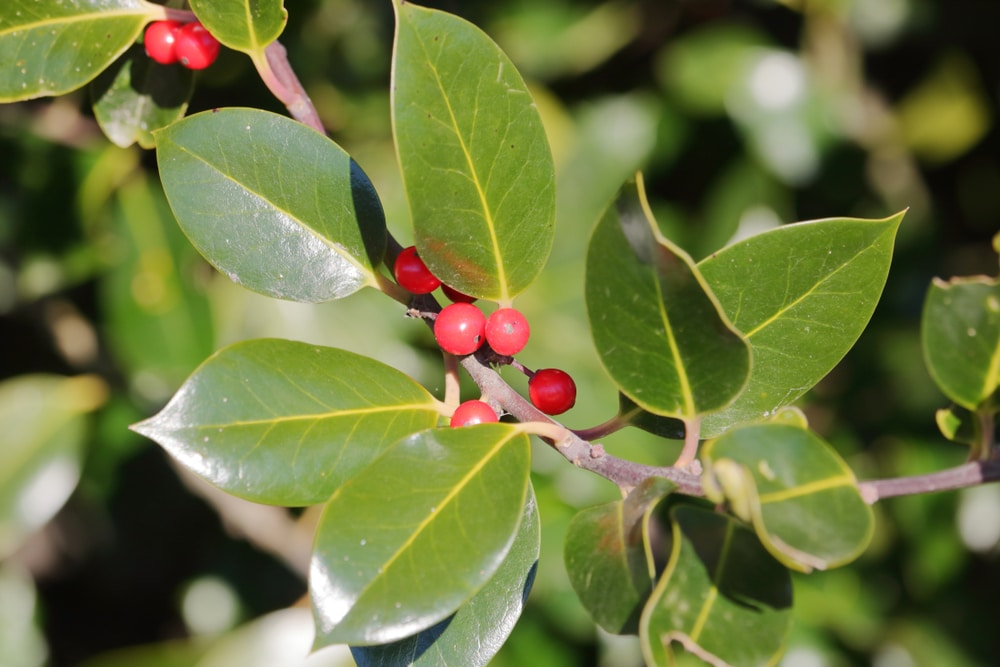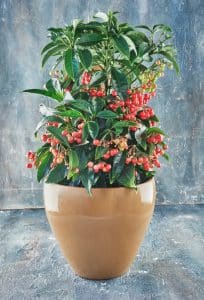The Dwarf Burford Holly is an attractive plant with the following main facts:

| Botanical Name | Ilex cornuta |
| Common Name | Dwarf Burford, Chinese holly, Burfordii Nana |
| Plant Type | Perennial |
| Flower Color | White, fragrant, less than one inch |
| Size When Mature | 6-8′ tall, 4-6ft wide |
| Bloom Time | Spring |
| Sun Requirements | Full Sun, Partial Shade |
| USDA Hardiness Zones | 7-9 |
| Soil PH Range | 6.1-7.3 |
| Soil Type | Neutral-to-Slightly Acidic, Well-drained |
| Water Needs | Low |
| Native Area | China, Korea |
What You Need to Know About Dwarf Burford Holly
Dwarf Burford Holly (Ilex cornuta ‘Burfordii Nana’) is a slow-growing, compact evergreen shrub that is native to Asia (Commonly found in China and Korea). It’s perfect for use as a low hedge or foundation plant, thanks to its compact and dense growing habit.
It has small, rectangular, glossy, dark green leaves and produces clusters of white flowers in the spring followed by beautiful red berries in the fall, lasting until the winter. This holly is quite tolerant of both sun and shade, making it a good choice for many different landscape situations.
And while the shrub has a slow growth rate, it is still able to reach a height of up to 8ft tall and grow about 4-6ft wide. It’s, however, recommended that you maintain the height of your plant at about 3-6ft tall by pruning it. That way, it will be easy to retain its density.
As for whether the dwarf Burford holly is toxic, you will want to avoid eating the berries as they can cause discomfort. While that may seem like something to make you frown, you will love the fact that these eye-catching berries don’t require cross-pollination.
How To Care for The Dwarf Burford Holly
There are a number of things that you need to have in mind when growing and caring for a dwarf Burford holly. Here are the most important:
Light
The dwarf Burford holly does best in full sun but can also tolerate partial shade. It’s important to note that the more sun the plant gets, the more vibrant its color will be. Plus, having this plant located in an area where it receives optimal sunlight is important to ensure proper flowering and berry production.
Soil
Even though the dwarf Burford holly is not so picky when it comes to the soil requirements, it does best when planted in rich soils that are slightly acidic.
As such, the ideal pH range for this plant is 6.1-6.5. It can, however, still grow pleasantly in neutral soils with a pH between 6.6 and 7.3. Well-draining soils are recommended as they help to reduce the chances of the plant developing root rot.
Watering
This holly variety is quite a drought tolerant once it has become established. However, during its first growing season, you will need to water it once per week to help it get established. After that, you can restrict watering to hot weather and dry spells.
Temperature Requirements
The dwarf Burford holly grows best in USDA hardiness zones 7 through 9. This means that it can withstand minimum temperatures of -10 degrees Fahrenheit.
Pruning
Even though the dwarf Burford holly is a slow grower, it will still require pruning to maintain its desired shape and size. The best time to carry out this activity is during the late winter or early fall prior to the opening of new buds.
Fertilizer
Fertilizing is only necessary if you want to encourage faster growth. If that’s the case, feed your plant in early spring, summer, and fall using a slow-release fertilizer that is formulated for evergreens. A top-quality granular fertilizer should be a good choice since it qualifies as a slow-release fertilizer.
Common Diseases and pests
The good news is that the dwarf Burford holly is quite resistant to pests and diseases. However, it can still be affected by a few problems including:
Pests such as the holly leaf miner, whitefly, spider mites, and scale. In addition, the dwarf Burford holly is also susceptible to diseases such as leaf spot, tar spot, leaf rot, and powdery mildew.
Dwarf Burford Holly Propagation
The best way to propagate the dwarf Burford holly is through rooting hardwood cuttings. You will need to choose stems that are about 6 inches long when the weather is cold.
When cutting the pieces from the parent plant, you should aim to cut just below the bud onions. Bud onions are the small, slightly rounded structures that are located at the base of the leaves.
The top of the cutting should be about three-quarters of an inch above the closest bud onion. That way, it will be easier to establish the top and bottom of the cuttings.
Since the cuttings will have leaves on them, you will want to remove all but the top two leaves before dipping the cut end into a rooting hormone.
After that, plant the cutting in moistened perlite or sand and place it in a propagating case or under a plastic cover. You will want to keep watering the plants on a regular basis during the entire fall, to counter the drying effects of the sand.
It will not be necessary to water your plants in the winter unless the weather is considerably dry. You will, however, want to resume watering from the spring as soon as new growth appears and throughout the entire summer.
For best results, it’s recommended that your only transplant your new plants in the next spring.

